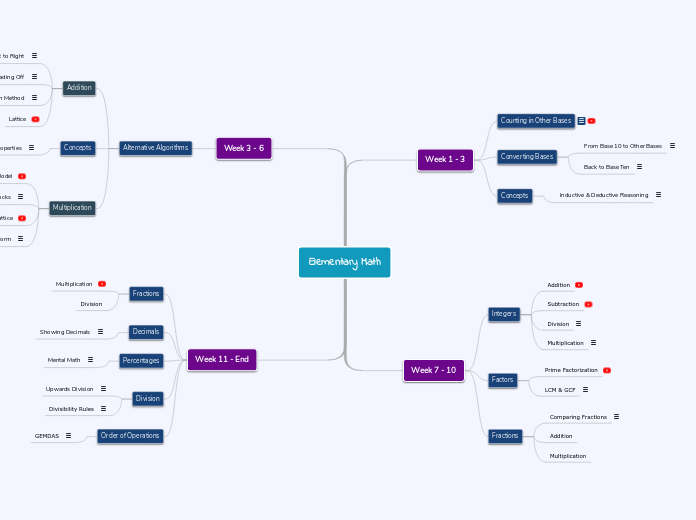
Counting in Other Bases
Use "units", "longs", and "flats" in place of ones, tens, and hundreds when counting in other bases.No individual number can be equal or higher than the base you're counting in. For example, if you're counting in base 4, you can't get 52 because 5 > 4.When the amount of units you have equals the base you're counting in, they become a long (in base 4, 4 units = 1 long)When you write a number in another base, make sure to include a written out subscript to show what base it is (13four)If a number doesn't have a subscript, it is assumed to be base 10.
aConverting Bases
From Base 10 to Other Bases
Ways to convert from base 10Using a diagramExample: convert 5 to base twoFirst, draw each individual unit. o o o o o= 5Count how many groups of two you can put together. Each group makes one "long". Then, count how many units are left over.(o o) (o o) o = | | oTwo longs and one unit = 215 = 21fourDivisionEx: convert 5 to base twoDivide the number you are converting by the new base 5 ÷ 2 = 2, remainder of 1So, 2 would be the amount of longs, and the 1 is the leftover units5 = 21four
Back to Base Ten
Ways to convert back to base 10 a. Using diagrams (Example: 23five)First, draw the amount of longs and units.23five = | | oSince we are currently in base five, that means each long is equal to five units. Knowing that, we can add all the units together.(5 + 5) + 3 = 1323five = 13 b. Using exponents (Example: 24301five)When using exponents, note that the units place is to the power of 0. The exponent increases by one with each place value.All you have to do is multiply each digit of the number by (basex)2(54) + 4(53) + 3(52) + 0(51) + 1(50)
Concepts
Inductive & Deductive Reasoning
Inductive reasoning recognizes patternsDeductive reasoning applies prior knowledge
Integers
Addition
Subtraction
Division
For both multiplication and division,If the signs are the same, the answer is positiveIf the signs are different, the answer is negativeExample: -18 / -3 = - / - = 6
Multiplication
When multiplying integers, you want to think of things this way:5(-2) is the same as "5 groups of negative 2"-2(4) is the same as "take away 2 groups of 4 positives"For both multiplication and division,If the signs are the same, the answer is positiveIf the signs are different, the answer is negativeExample: (10)(-15) = (+)(-) = -150
Factors
Prime Factorization
LCM & GCF
"LCM" stands for "Least Common Multiple". It is the smallest big number."GCF" stands for "Greatest Common Factor". It is the biggest small number.To find the LCM, you use all the numbers and the biggest exponents. For GFC, you only use common numbers and smallest exponents. For example:23426725325162LCM: 2532425167GFC: 2362
Fractions
Comparing Fractions
"Anchor Fractions" are fractions that help us compare, like 1/2< - "less than"> - "greater than"Examples:2/3 > 3/82/3 is more than 1/2, and 3/8 is less than 1/27/8 < 12/13While both missing one piece, 12/13 is missing a small piece, so it has more filled than 7/8
Addition
Multiplication
Alternative Algorithms
Addition
Expanded Form & Left to Right
Expanded Form124 + 163100 + 20 + 4100 + 60 + 3____________200 + 80 + 7= 287Left to RightStart at the largest place value145 + 121145121____200_60__6= 266
Friendly Numbers & Trading Off
Friendly NumbersLooks for tens21 + 13 + 7 + 19 + 12 + 18 + 530 + 20 + 0 + 10 + 10 + 20 + 5= 95Trading Off27 + 1627 + 1623 + 20= 43
Scratch Method
Scratch Method11 22 41 5 11 01 12 1___9 3
Lattice
Concepts
Properties
Commutative PropertyEquations in a different order still have the same value when adding or multiplyinga + b = b + aAssociative PropertyNumbers can be grouped in any way when adding or multiplying(a + b) + c = a + (b + c)
Multiplication
Area Model
Base Ten Blocks
Multiplying with Base Ten Blocks
Lattice
Expanded Form
Expanded Form Multiplication13(12)10 +310 + 2_______Multiply each number together (except those that are part of the same number)Then, add all of those answers together= 156
Fractions
Multiplication
Division
Decimals
Showing Decimals
Showing decimals is pretty much the same as how we show fractions, except our boxes will only ever be cut into 10s or 100s.Example: Addition
Percentages
Mental Math
What is 60% of 50?To find this in your head, first do this:10% of 50 = 5Then, you multiply to make 60%:10% x 6 = 60%, 5 x 6 = 30So, 60% of 50 is 30What is 45% of 80?To find this, you follow the same steps above, plus one more. To find the extra 5%, you just do half of what 10% was. In this case, 10% of 80 was 8, so 5% is 4.
Division
Upwards Division
Divisibility Rules
Divisibility Rules2: all even ended numbers are divisible by 23: sum of the digits is equal to a multiple of 34: last two digits of the number are divisible by 45: anything that ends in a 5 or a zero6: number divisible by both 2 & 38: last three digits are divisible by 89: digits add to a multiple of 910: anything that ends in a zero
Order of Operations
GEMDAS
GroupsExponentsMultiplicationDivisionAdditionSubtractionUsing GEMDAS instead of PEMDAS will eliminate any confusion about the use of parentheses to mean multiplication.